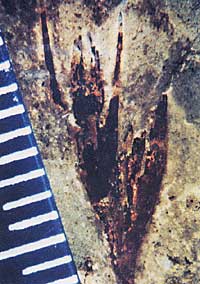|

 |
|
|
Color photo
shows seed, on left side sticking up between two tall spikes
(compare to line drawing). Blue-and-white scale indicates seed
is about 5mm long (shown 4.5x natural size). Black areas are
actual carbon from the original 360 million-year-old seed. Line
drawing is a reconstruction of three seeds (shaded) within
a cupule (the tall, four-pointed hand-like parts). Parts have
been cut away from two of the seeds to show internal construction.
(Photos and drawing courtesy of William Gillespie)
|
By Fred Schroyer
Most plants we see today reproduce by seeds, and
this has proven to be a very successful and reliable method. But
360 million years ago, most plants reproduced by spores. Seeds were
something new, an experiment in carrying the genetic code from one
generation to the next.
Seeds from very early in this experimental period
have been discovered in Devonian-age rocks in Randolph County. Only
a quarter-inch or so long, carbon-black in the light brown rock,
and borne within a hand-like cupule, these seeds are the oldest
known in the world (color photo). It has not yet been proven to
which plant they belonged, but the list is rapidly being narrowed
as the study continues.
The seeds were discovered by William Gillespie,
who is no newcomer to fossil plants. He is Assistant to the Commissioner
of Agriculture for West Virginia, an adjunct Associate Professor
of Geology at West Virginia University, and a fossil plant collector
for some 30 years. He is also coauthor of one of the West Virginia
Geological and Economic Survey's most popular publications, Plant
Fossils of West Virginia.
Gillespie says that work leading to the find began
several years ago when the West Virginia Geological and Economic
Survey asked him to examine some fossil plants found near a thin
coal bed in Randolph County. The fossils were abundant and well-preserved,
and he identified them as late Devonian in age, or about 345 million
years old.
In the winter of 1979-1980, he was consulted by
the U.S. Geological Survey to help study the geology of the same
area, using his knowledge of plant fossils. Digging deeper than
before, he found masses of fossils, including bark, twigs, the leaves
of several plants, and seed cupules (the hand-like part holding
the seed, shown in the drawing), but no seeds.
Soon, however, Gillespie was contacted by Gar Rothwell
of Ohio University and Steven Scheckler of Virginia Polytechnic
Institute, both plant-fossil specialists interested in finding fossil-
collecting sites. He led them to the place where he had found the
cupules.
It was "the most fantastic two hours of digging
I ever put in," Gillespie says. On this and subsequent days,
over 200 seeds were found, beautifully preserved. "It's very
exciting. The time of origin of the seed plants is one of the big
mysteries in science. And I expect more dramatic finds in the next
few years…the West Virginia site is very important to science
because many of the fossils have their internal anatomy preserved,
making detailed study possible. This site may be, and probably is,
the most productive Devonian-age plant-fossil locality ever found."
The seeds, other plant parts, and some fossil animals from the site
are now being studied by specialists across the nation.
Gillespie cautioned that someone, he hopes himself,
may some day find even older and more primitive seeds, but until
this happens the 200 specimens from Randolph County will carry the
record.
Gillespie expects to see at least a dozen scientific
papers published on the fossils already found. He added, "We
are pleased that members of the West Virginia Geological and Economic
Survey have played a role in one of the decade's most important
scientific discoveries."
Further Reading
The Earliest Seeds: W.
H. Gillespie, G. W. Rothwell, and S. E. Scheckler, technical article
in Nature, Vol. 293, No. 5832, October 8, 1981, pp. 462-464.
Plant Fossils of West
Virginia: W. H. Gillespie and others, 1978. Excellent introduction
to how fossils formed, fossil collecting, and identification guide
with hundreds of photographs; text used in college courses. Publication
ED-3A, $4.00 (to order, see Contents page).
(Article reprinted from Mountain State
Geology, December 1981.)
|

